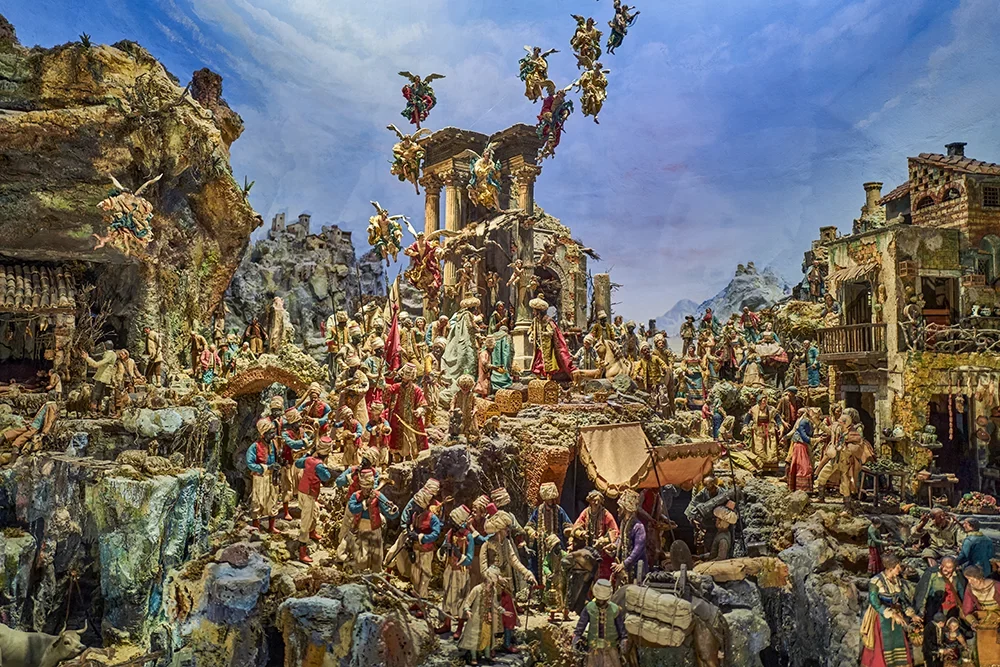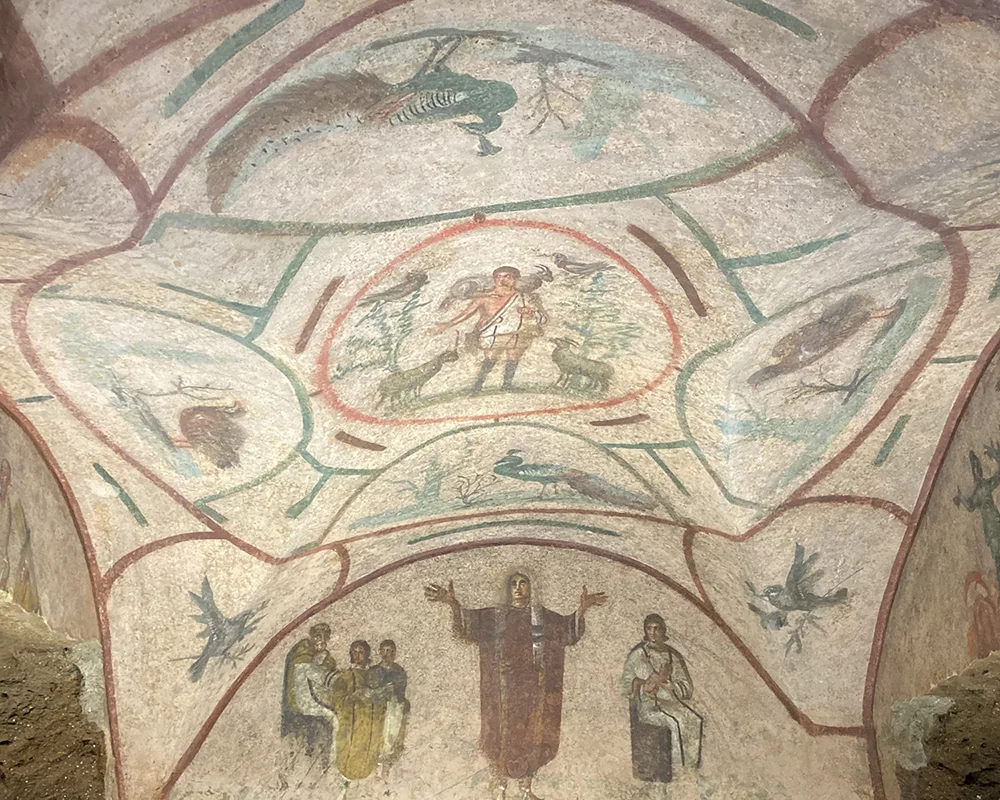- BY ISSIMO
- November 29, 2023
Discovering Naples’ Nativity Scene Tradition
Why the southern Italian city is the capital of presepi

Christmas in Italy is synonymous with a lot of things: panettoni and pandori, long feasts that last from Christmas Eve to New Year’s Eve, a myriad of different foods that change from region to region. And, of course, presepi – nativity scenes.
If you’ve ever visited a Catholic church, home or country around the holiday season, you’ll know what we’re talking about: depictions of Jesus’s birth through figurines, art objects and sometimes even real people, displayed proudly the moment December starts.
In the boot-shaped country, they’re a big deal – though nowhere does them better than one specific town: Naples.
The southern Campanian city is in fact considered to be the worldwide capital of the nativity scene, thanks to the craft that developed there in the 15th to 18th centuries.
Neapolitan nativity scenes are now displayed in museums and visited by people from all over the world, and, over time, have transformed from merely a seasonal custom to a cultural phenomenon that paints the streets with the hues of faith, folklore, and Neapolitan artistry, making much of the cultural fabric of the city.
But how did the art first evolve, and where can you catch a glimpse of it today? Read on.
A storied history
A display of sculptures or living individuals, the nativity scene, along with the closely linked Adoration of the Magi, can be traced back approximately 1,500 years. As Christianity has undergone transformations, so too has this tradition, adapting to new interpretations and meanings over the course of time.
In Italy, the scene is called presepe after praesepire, a Latin verb meaning to fence or enclose that refers to the crèche (a French word derived from the Latin cripia, or crib) – the key element characterising all nativity scenes.

Saint Francis of Assisi has long been considered as the first to introduce the concept in 1223 – according to his followers, he commemorated the birth of Jesus by arranging a manger with hay, an ox, and a donkey in Greccio, Umbria – although that’s actually not correct. Visual depictions of Jesus’s early life date earlier – so much so, in fact, that one of the oldest known renderings of the Adoration of the Magi, or the Epiphany is a late third- or early fourth-century wall painting in the Catacomb of Priscilla in Rome.

It didn’t take long for the popularity of the nativity scenes to grow. In 1291, Pope Nicholas IV ordered the installation of a permanent nativity in Rome’s Basilica di Santa Maria Maggiore and, by the time the Renaissance came around, artists were following suit, too. Nativity scenes were a common subject for anyone from Botticelli to Andrea Mantegna and Fra Angelico but also sculptors, with several craftsmen creating nativity figures from wood and clay.

By the mid-1500s, scenes could be found throughout the Italian peninsula, but it’s in Naples they began to shine brightest. In the late 15th century, brothers Pietro and Giovanni Alamanno crafted life-size sculptures of religious figures in paint and gold leaf to display in local chapels. Some time later, in 1530, Saint Cajetan of Thiene presented a wooden nativity scene featuring characters dressed like the Neapolitans of his days.
During the eighteenth century – the flourishing era of Neapolitan presepi under the patronage of King Charles III – an intriguing connection emerged with the golden age of Neapolitan theatre. Nativity scenes, often made in papier-mâché, turned into vibrant theatrical productions, portraying not just the sacred figures but also the entire spectrum of Neapolitan life.
That tradition still stands today – as do the techniques employed in creating presepi and pastori figures, which have seen minimal alteration. Artisans might fashion bodies from clay or linden wood, utilising metal pins for assembly, terracotta for the heads, blown glass for the eyes and authentic hair to create wigs. Under the Neapolitan school, garments are made from opulent fabrics and additional accessories, such as wax and papier-mâché elements, contribute to the intricate detailing.
The artistry involved in crafting landscape settings, including grottoes, caves, and cityscapes, also remains a specialised and revered tradition. Some of these meticulously crafted settings are astonishingly elaborate, featuring lighting effects and mechanical components that bring them to life with movement or sound. Others are just plain lush, with a thousand details and beautiful, complex scenographies.
Regardless, what makes them truly special is their ability to transcend the sacred narrative, seamlessly blending the divine with the mundane. These scenes encapsulate the essence of Neapolitan life and culture, capturing the nuances of daily existence. The figures are not static; they are dynamic, telling a story that extends beyond the nativity and resonates with the rich tapestry of Naples.
It’s no wonder they are protected by UNESCO under their program for Masterpieces of the Oral and Intangible Heritage of Humanity.
Stunning presepi and where to find them
A visit to Naples to admire presepi really is a must during Christmas. For the very best, head to San Gregorio Armeno, aptly named “Christmas Alley,” the epicentre of this age-old tradition.
The bustling street, lined with artisan workshops, comes alive during the holidays with skilled craftsmen meticulously fashioning nativity scenes that are veritable works of art. From the central figures of Mary, Joseph, and the Baby Jesus to the bustling backdrop of a miniature Naples complete with pasta makers, pizza vendors, and locals engaged in everyday activities, the presepi of San Gregorio Armeno are a testament to the intricate craftsmanship and attention to detail that defines Neapolitan artistry.
Popping into the historic churches of Naples during the Christmas season also unveils grand nativity scenes, each a testament to the city’s profound connection to its religious and artistic heritage. Try San Lorenzo Maggiore, at the end of the via San Gregorio Armeno, which hosts a small but impressive collection of Neapolitan presepi made for this church in the eighteenth century, all made from polychromed wood and terracotta.
A room off the cloister of the Complesso Monumentale di Santa Chiara also contains an impressive display of historic Neapolitan presepi, as does the Royal Palace of Naples, where you’ll find a monumental nativity display that gets bigger each year, as artisans regularly introduce new elements to it.
But there’s more.

The Museo Nazionale di San Martino is home to the world’s most impressive collection of Neapolitan presepi, including the presepe Cuciniello, which for a long time, was claimed to be the largest nativity scene in the world. Created by Neapolitan architect Michele Cuciniello, it dates to 1879, and has remained unchanged for over 100 years (for the actual largest presepe in the world, you’ll have to go to Manarola, in Liguria, where a 1961 life-size nativity scene has made it into the Guinness World Book of Records for its over 300 characters connected by seven miles of electric cables).
Then there’s the baroque presepe of the Capodimonte Museum and Real Bosco, which brings together three different nativity groups from the 18th century that were later joined to form a single scene; and the Presepe Favoloso of the Basilica of Santa Maria della Sanità, by the Scuotto brothers, longtime Neapolitan nativity scene masters, with wonderful shepherds and beautiful scenery, which has been donated and preserved here since 2021.

Want to bring some figurines home? Prices range from a few to a thousand euros, and you’ll find the best ones on Via San Gregorio Armeno. Try Fratelli Capuano (they’ve been at it since 1840), Arte Ferrigno and Gambardella Pastori e Presepi.
Happy exploring!